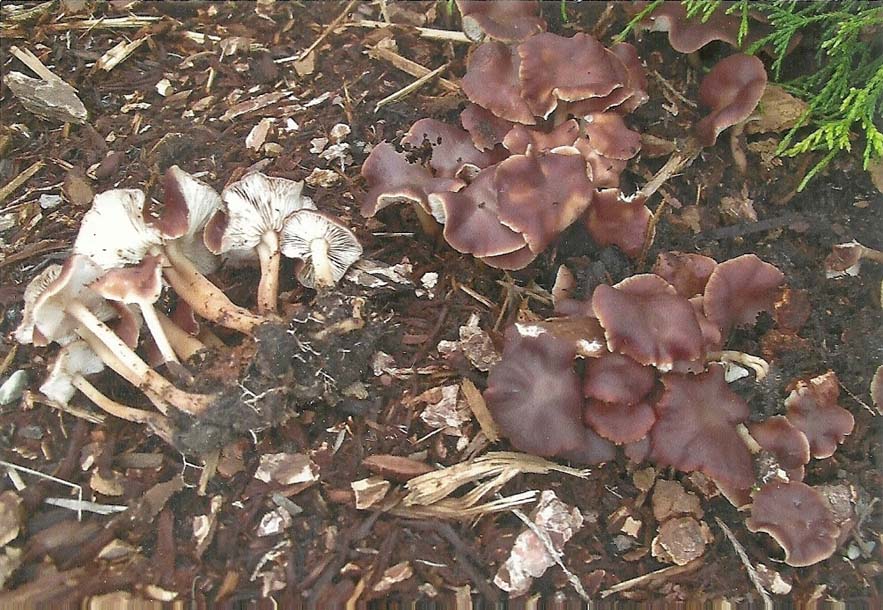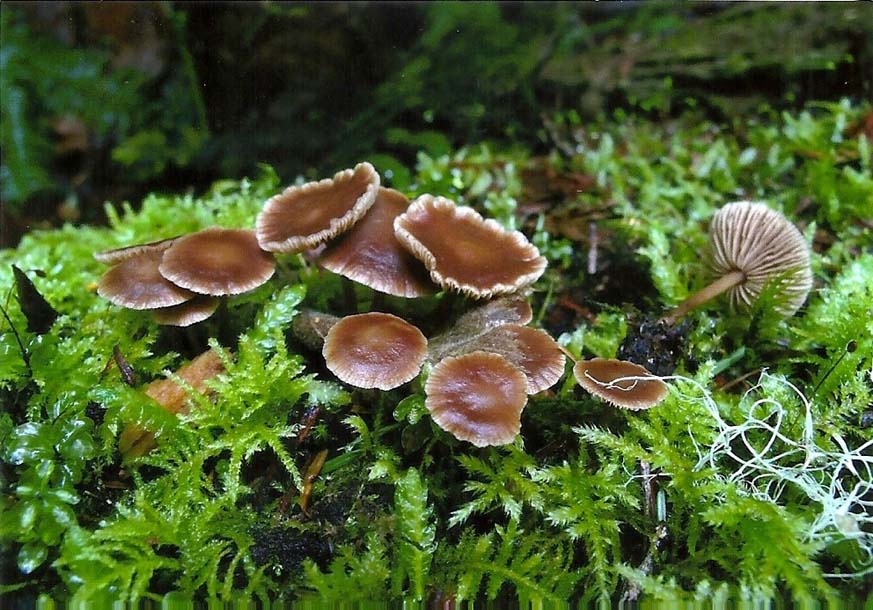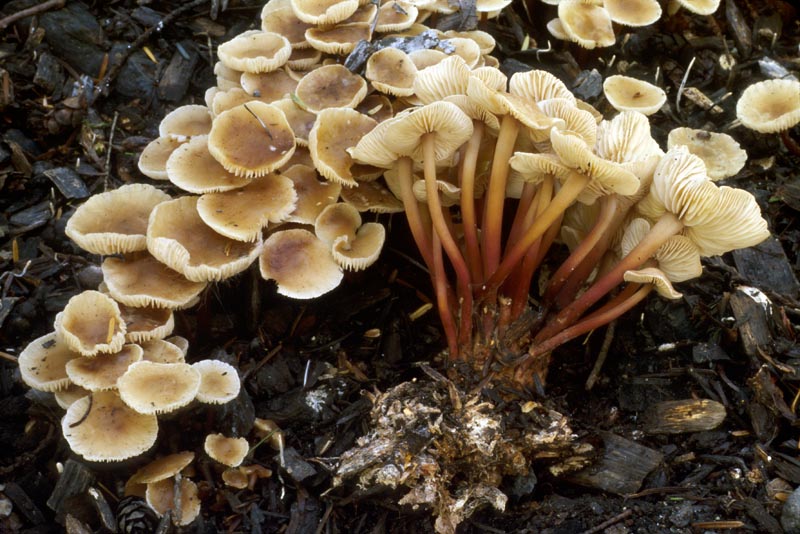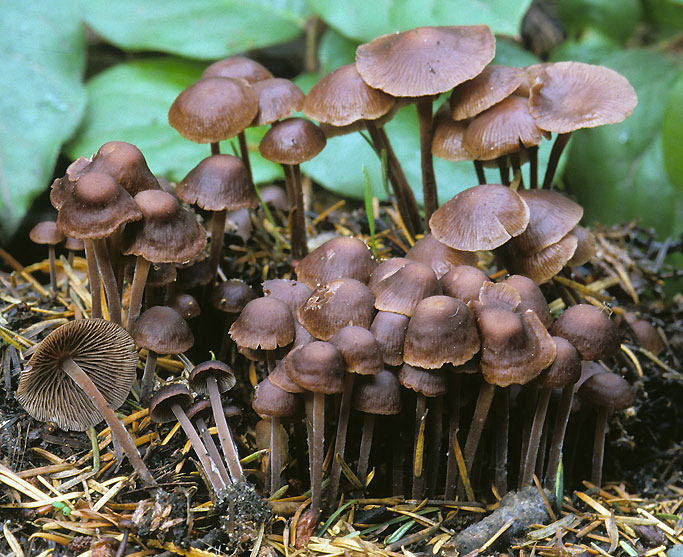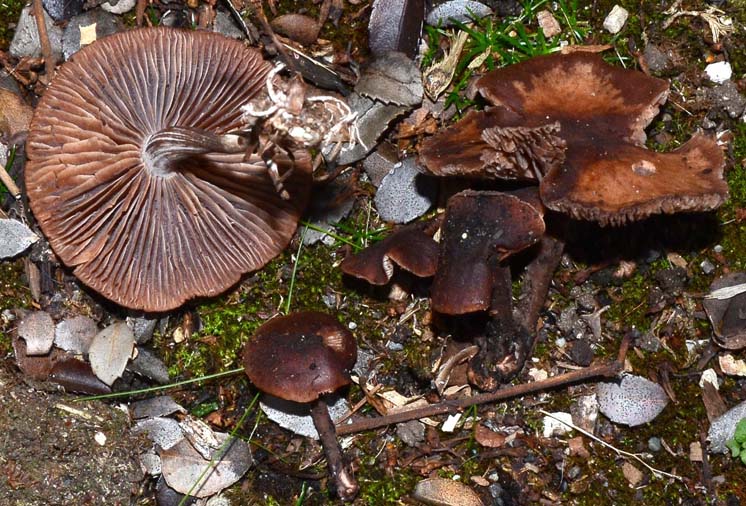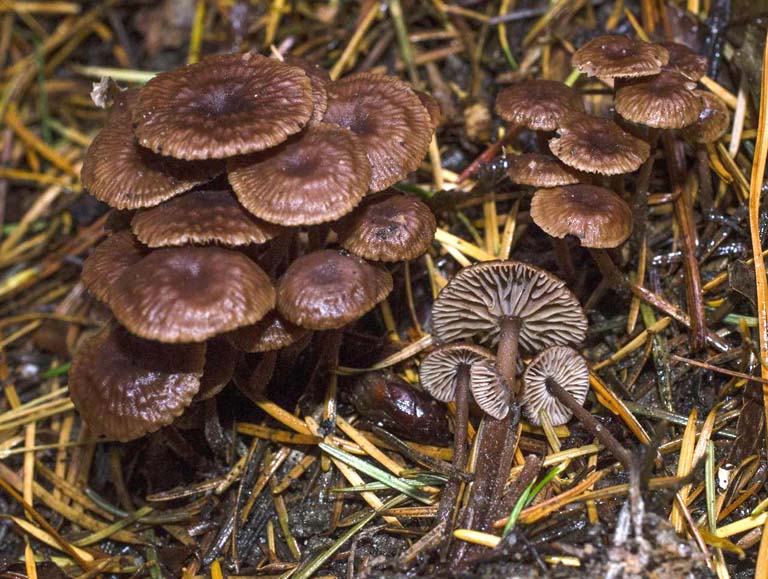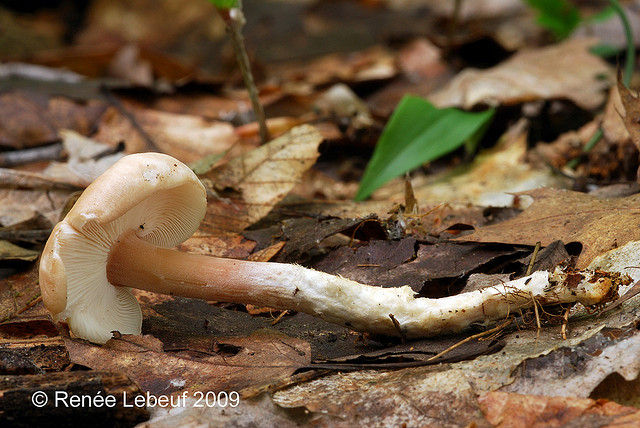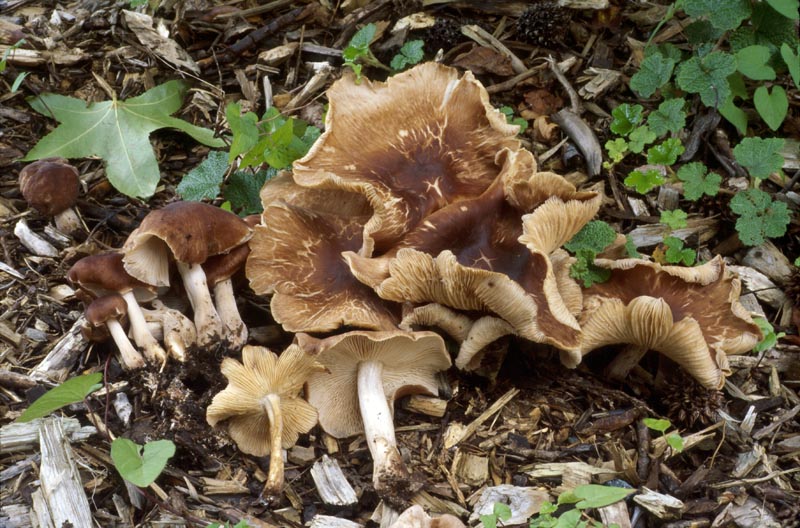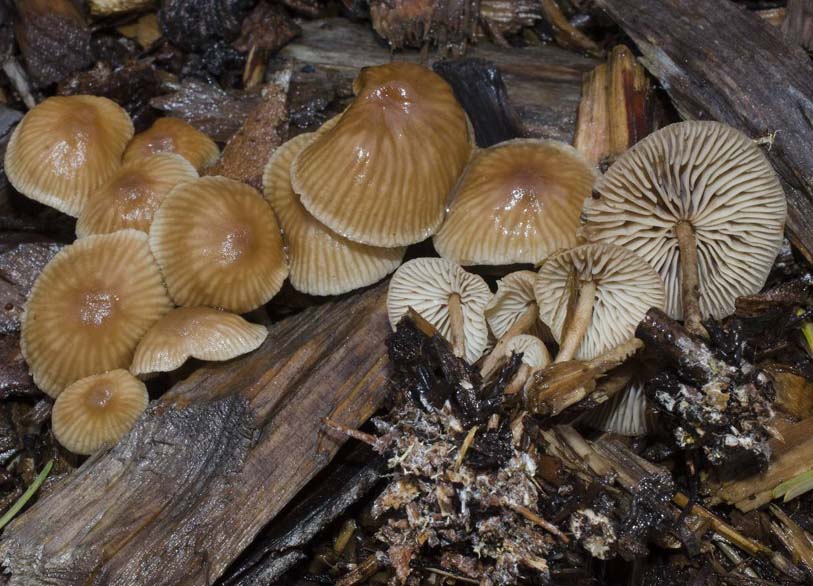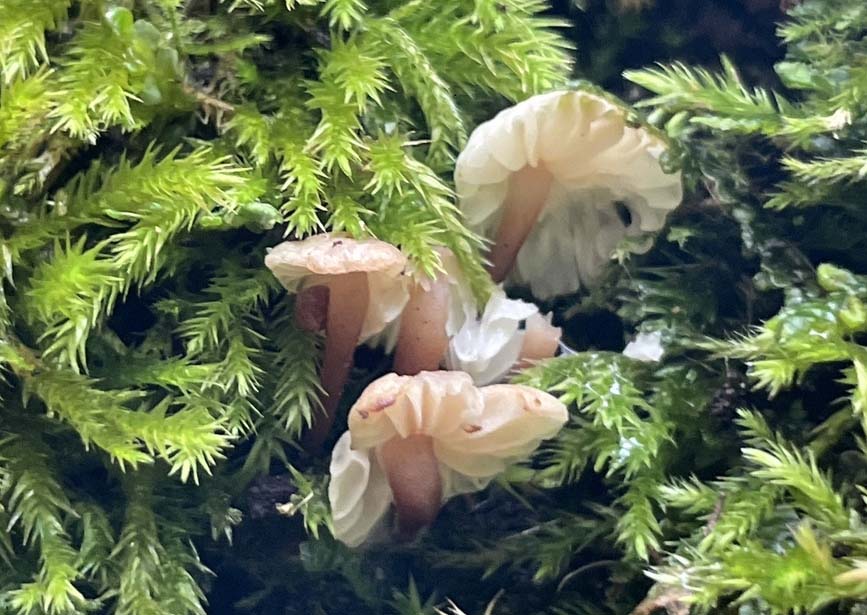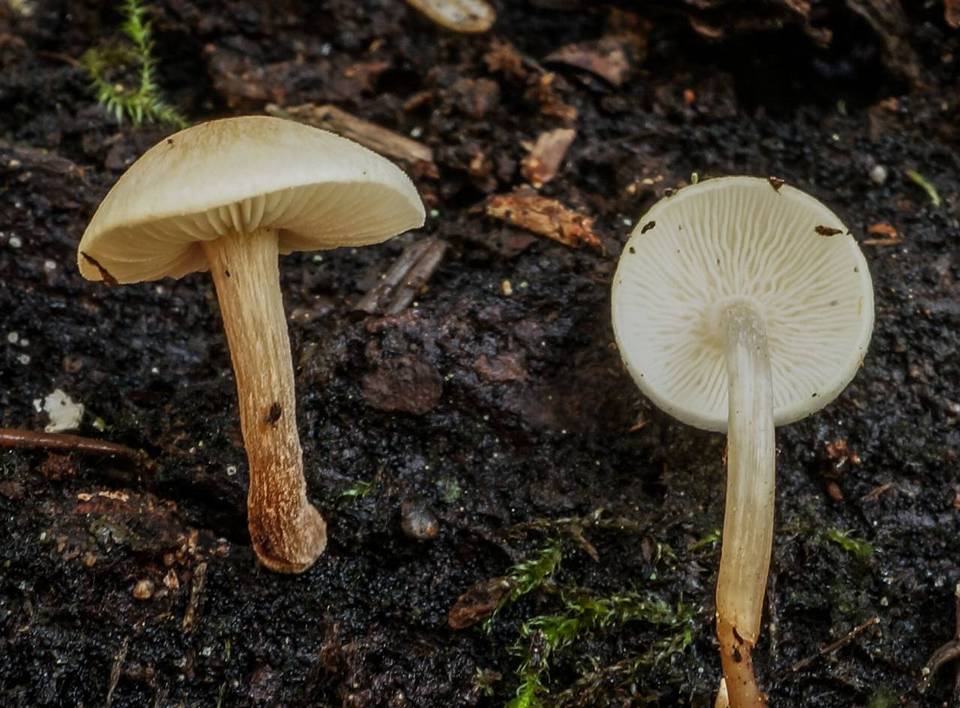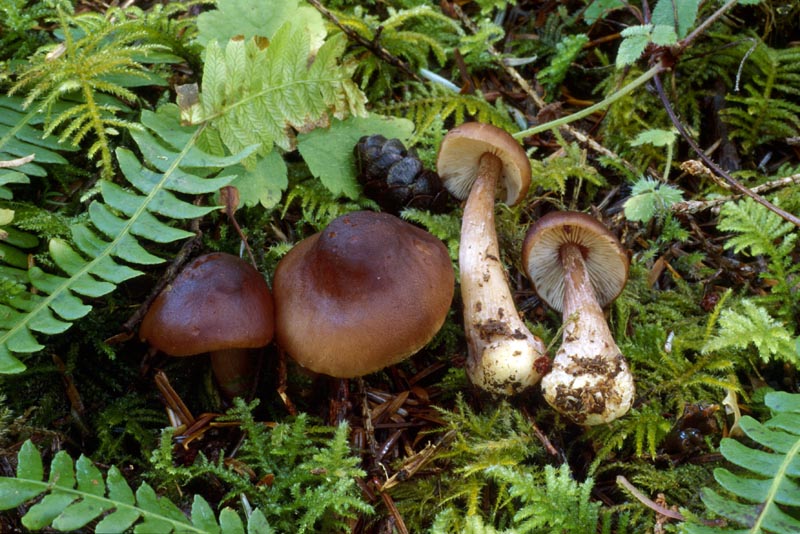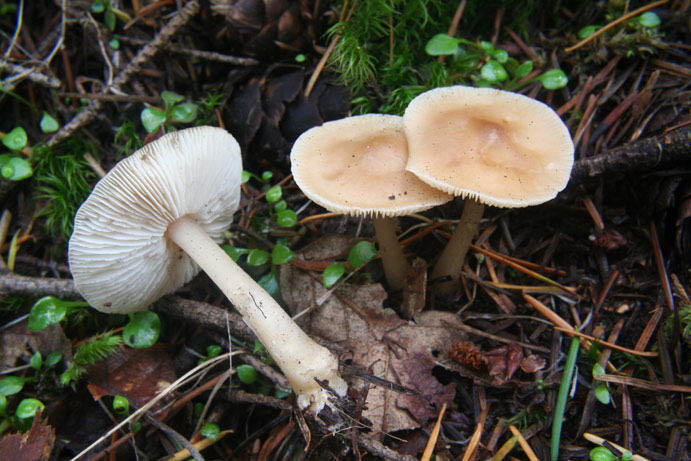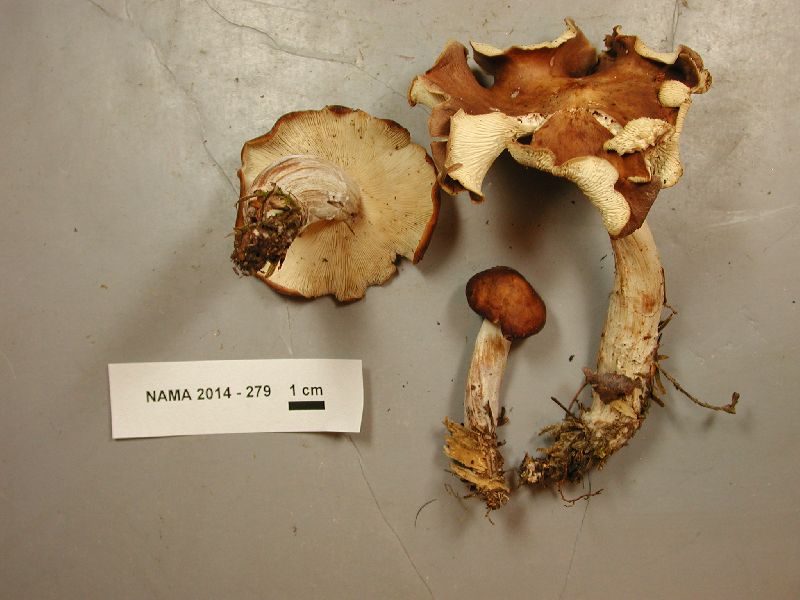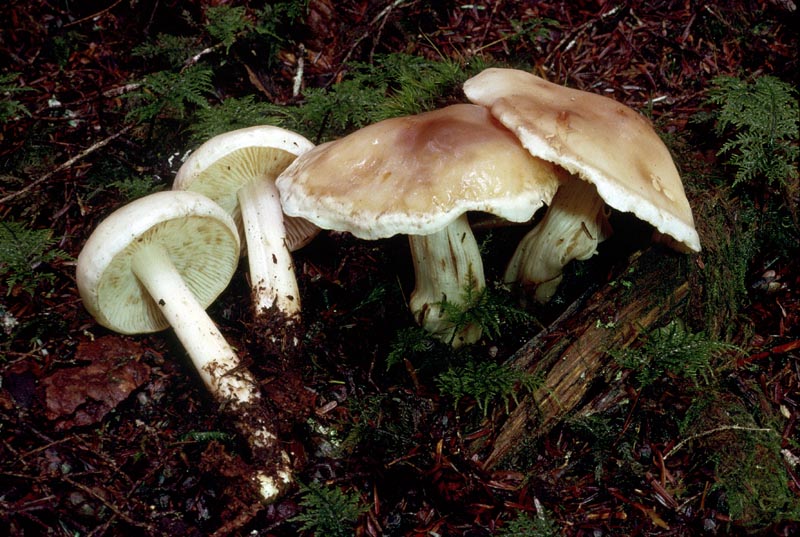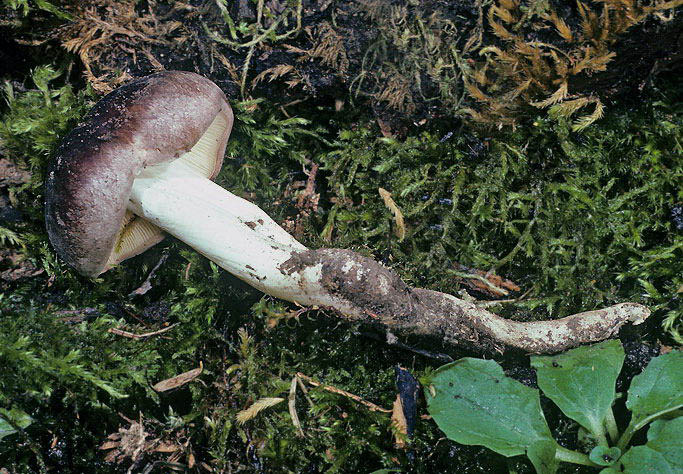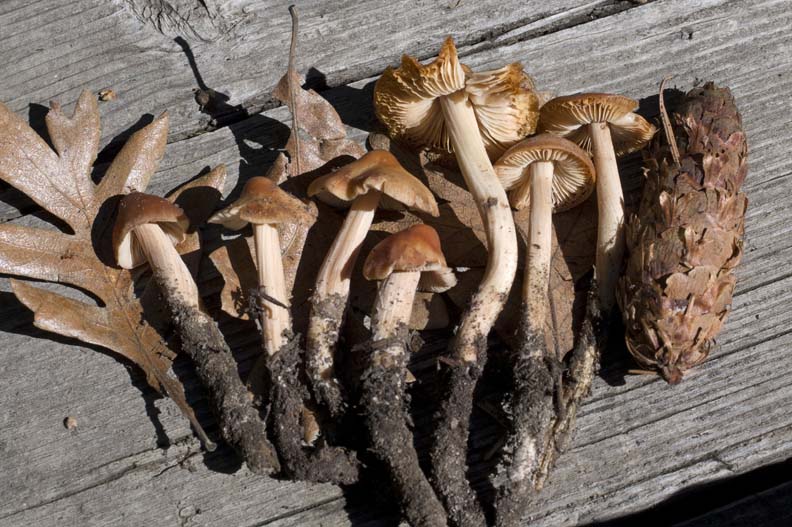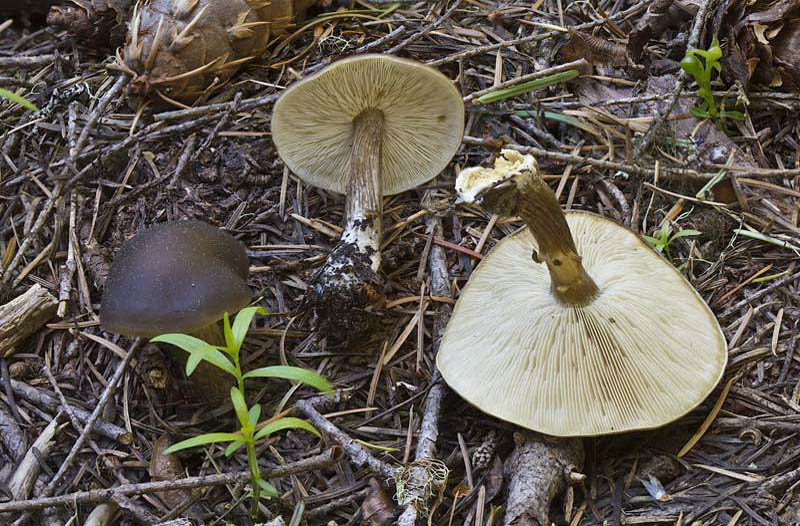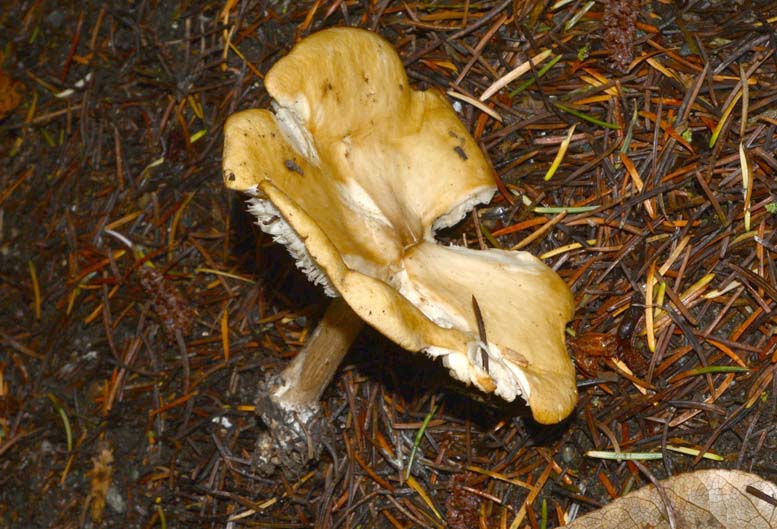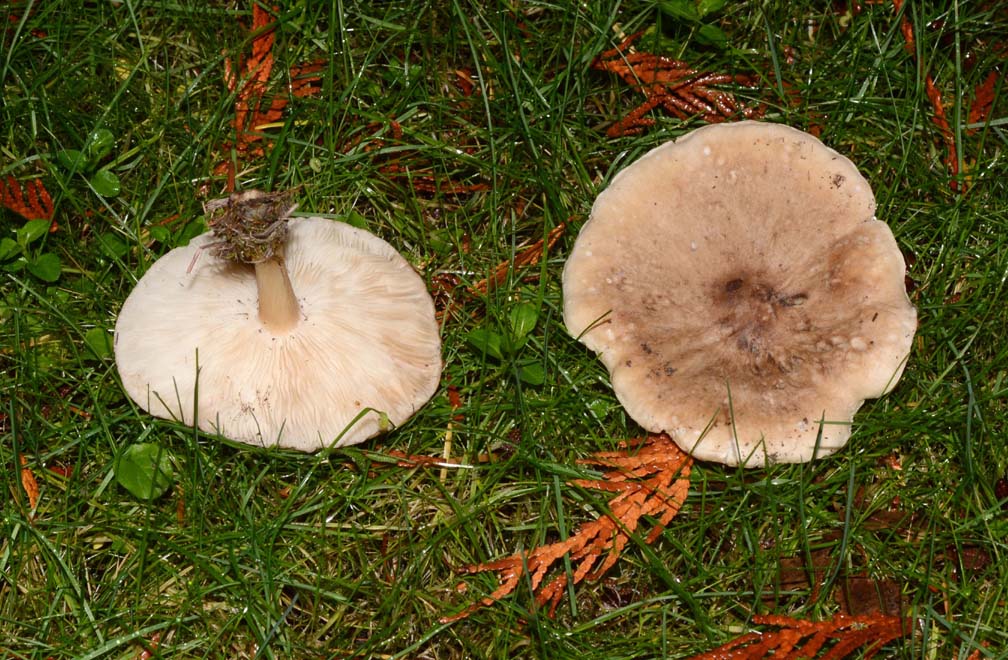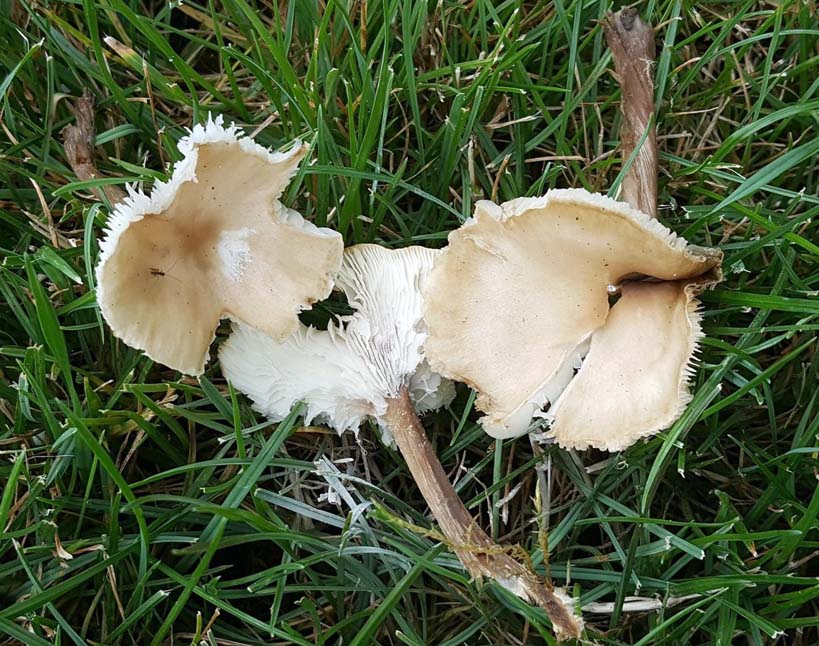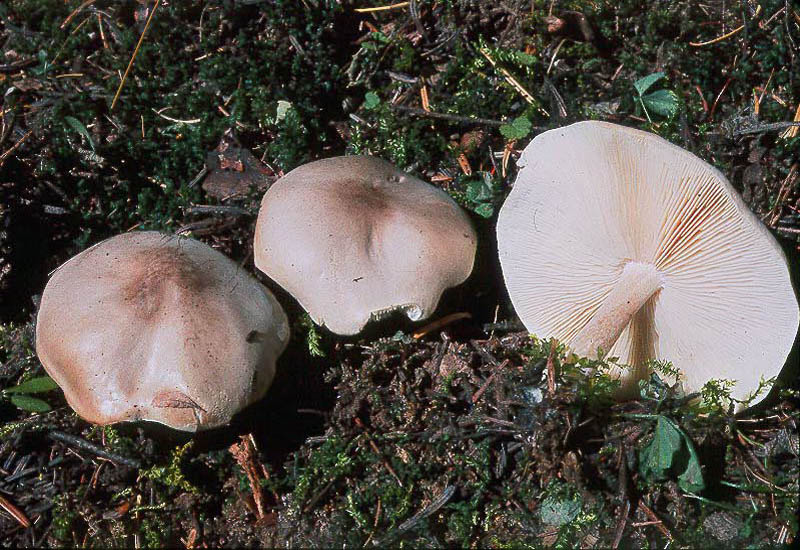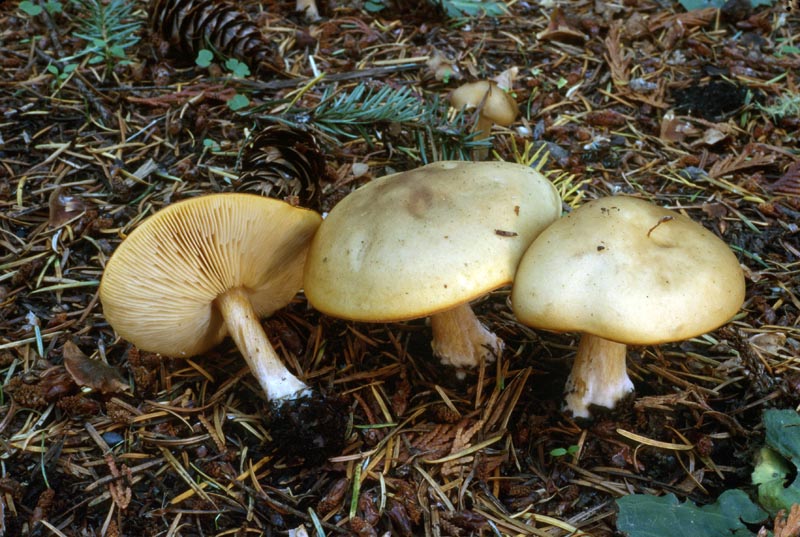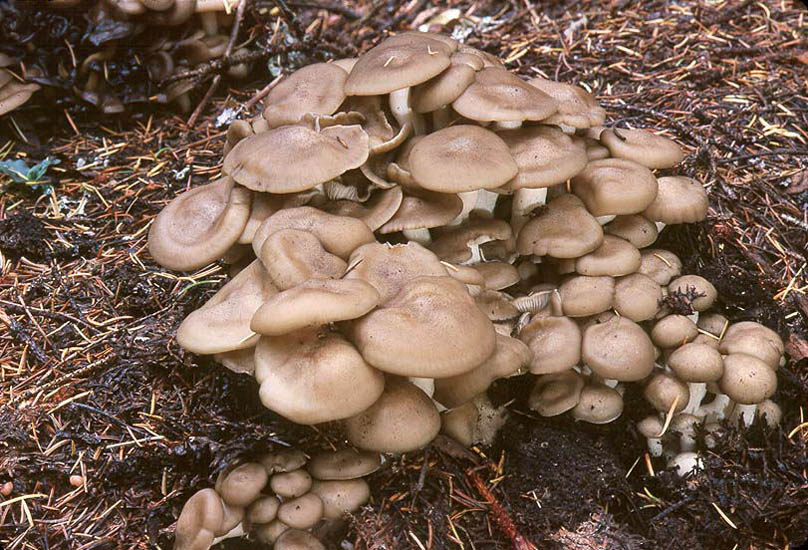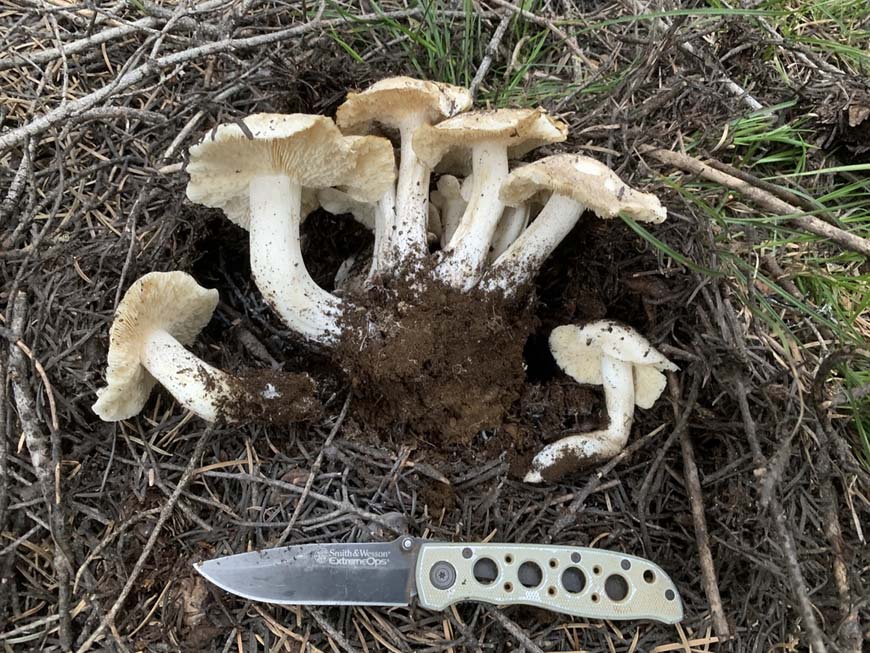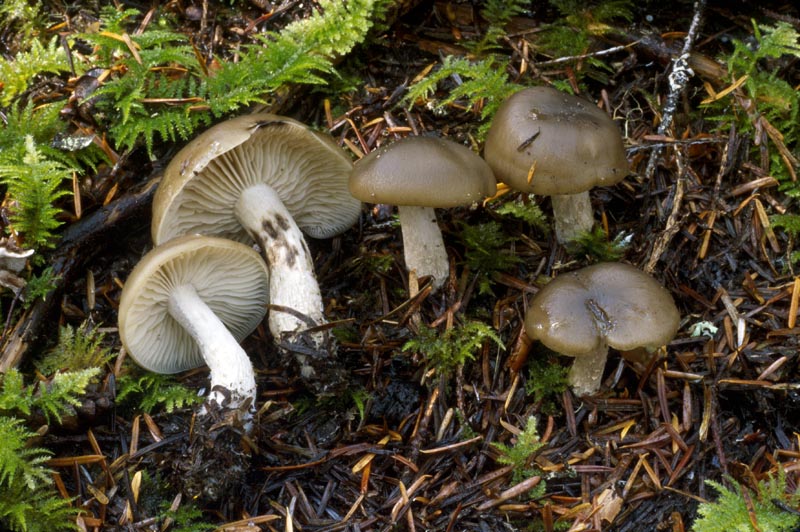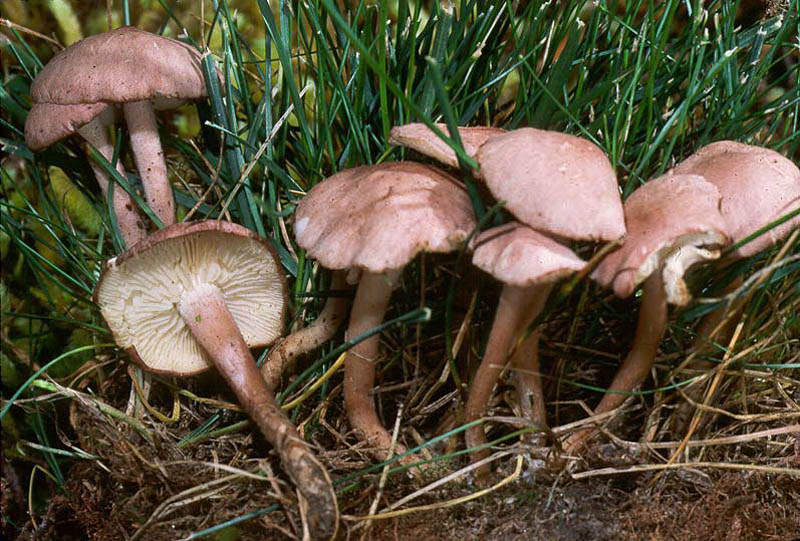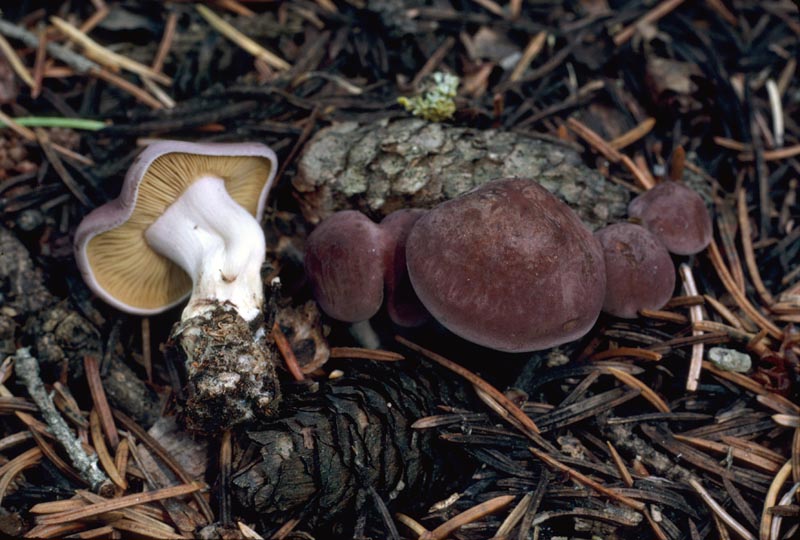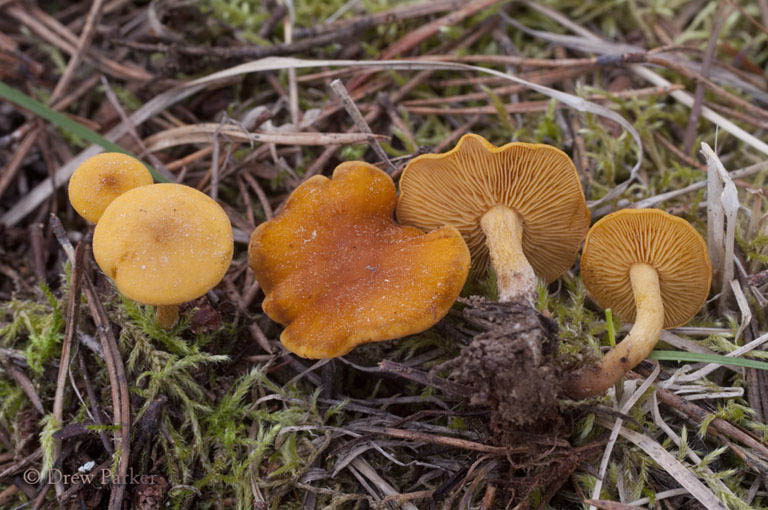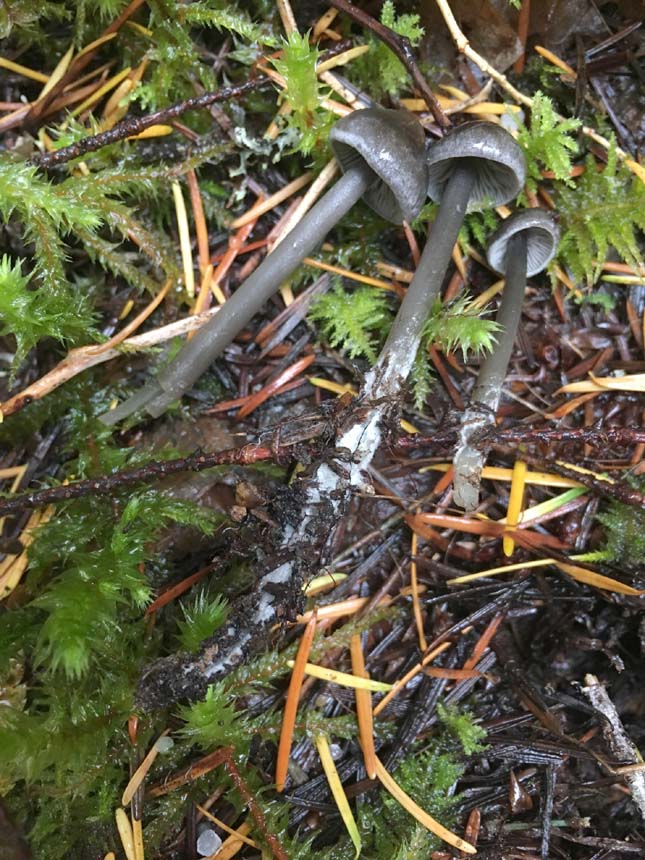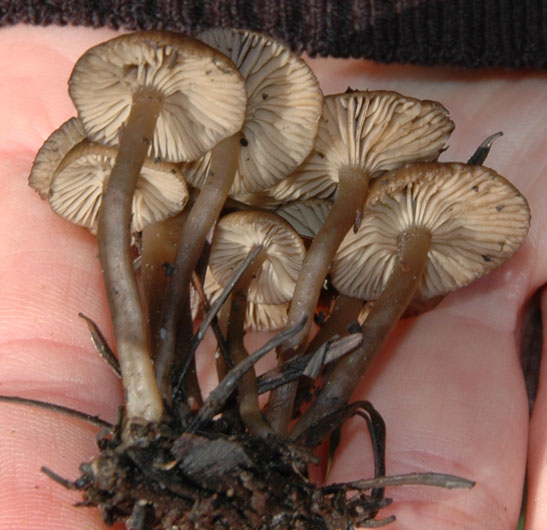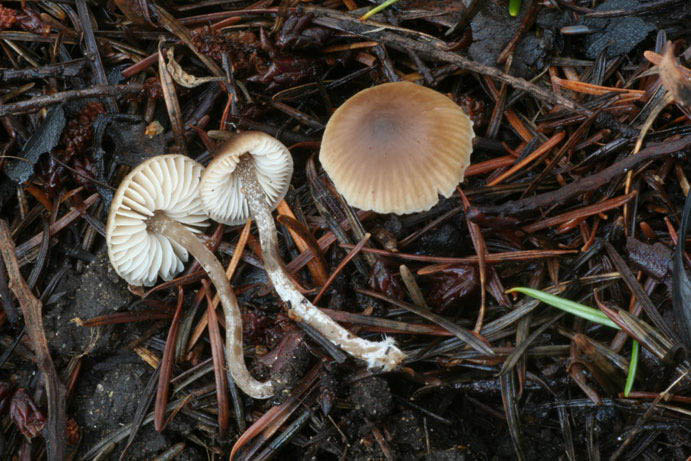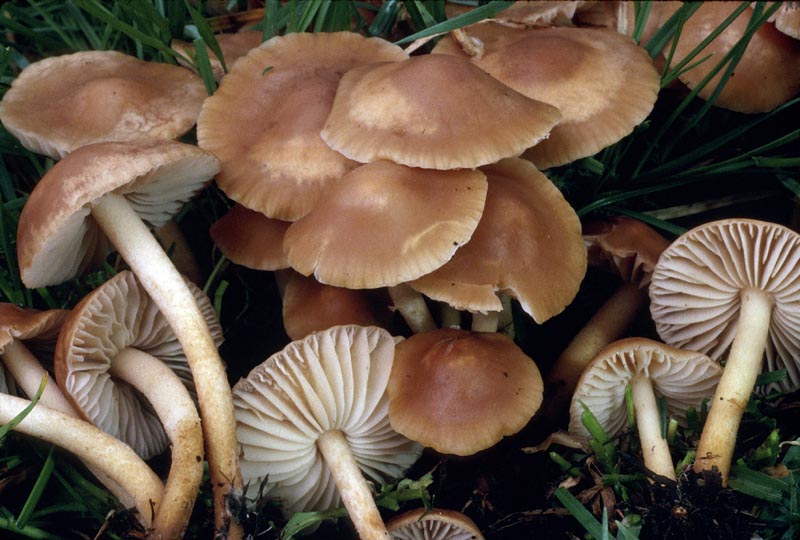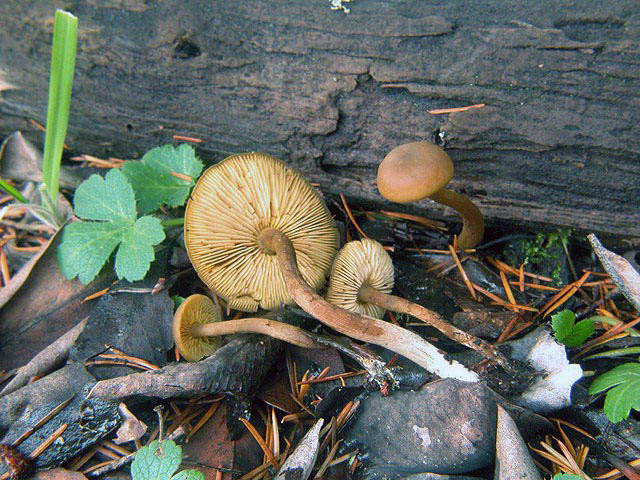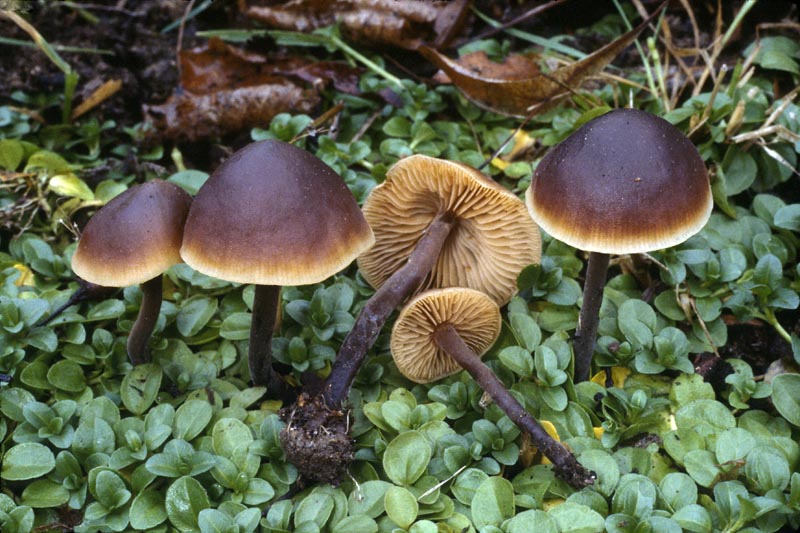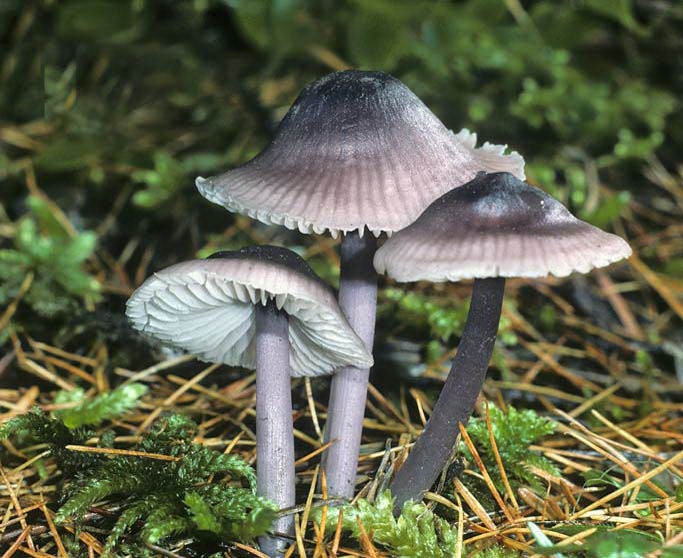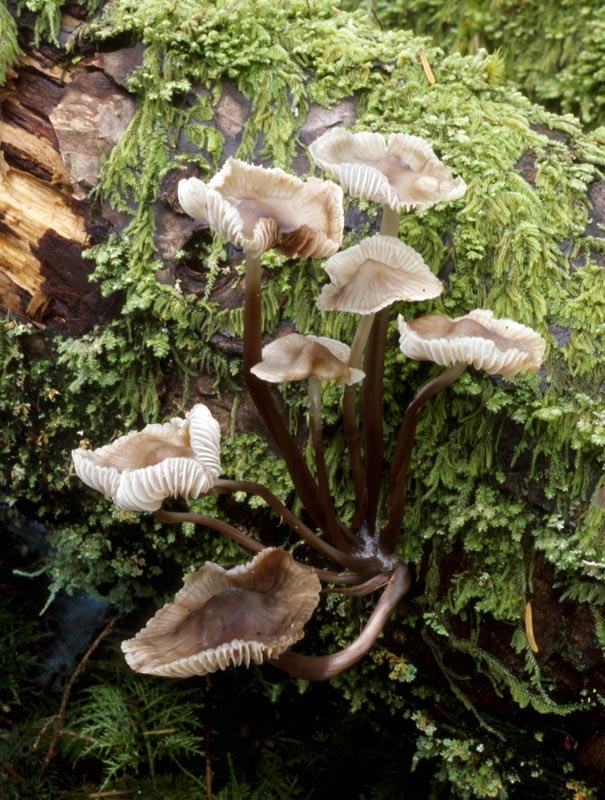Collybioid
These are
usually found on the ground but are
saprophytic (often growing on
debris or cones) and belong to the Marasmioid clade
unless otherwise specified. This is a pretty big catch-all page for many
miscellaneous white spored mushrooms, and will unfortunately require a lot of
browsing.
- Collybia/Asterophora - growing on other
mushrooms or their rotting
sludge. May not even have proper gills.
- Strobilurus/Baeospora - growing on cones or if not, with a
two-toned orangish stem.
- None of the above - the rest are
difficult to characterize, so unfortunately you will have to browse this
rather large section.
Collybia - When Collybias were
found to not be all related to each other and the larger ones were split into
Gymnopus and
Rhodocollybia, it was unfortunately the atypically small Collybias that got to
keep the name, simply because they had the name first, creating confusion. So "collybioid stature" really means big
like things Collybia used to be, not small things like Collybia is now. On behalf of mycologists everywhere, I apologize.
They are not
related to Marasmius and Gymnopus, but to the Tricholomatoid
clade. In fact they are very closely related
to Clitocybe. (Very. Unfortunately, they
may actually be Clitocybes, which doesn't help the confusion any).
These can be recognized by their small size (<1cm),
preference for growing on old rotting
mushrooms (often an old Russula turned into an
unrecognizable black pile of goo), closely spaced gills and by often having sclerotia at the base of
the stem - a tight little pill ball of nutrients. The caps and stems are pale and not tough
nor wiry,
so they are most likely to be confused with Strobilurus/Baeospora
and Asterophora.
Hygrophanous. There is usually no odor (although my collection of C. cookei
below smelled mysteriously of black licorice, perhaps the host mushroom did).
C. tuberosa - sclerotia
are dark and brown, small and seed shaped.
C. cookei - sclerotia are brighter, larger, round and
wrinkled.
Dendrocollybia racemosa -
<1cm, you can't miss the
branches all over the stem of this rare little gem, where
asexual spores are produced. It has round, black sclerotia and also grows on old rotting
Russulas.
Sometimes it is capless.
D. pycnoramella n.p. - shorter, denser branches.
Asterophora - growing on decaying
Russula/Lactarius
remains, these are related to Lyophyllum in the
Tricholomatoid clade. Not hygrophanous. One species may be almost lacking in gills and not
recognizable as a gilled mushroom and mistaken for an
earth tongue, but the brown powdery cap will hopefully give
it away. Due to their warty spores and parastic ecology, they are
probably most closely related to Tephrocybe.
A. lycoperdoides - cap is dusted with brown
asexual spores, gills almost absent.
A. parasitica - true gills, not dusty, wider spaced gills than Collybia, which it is
most likely to be confused with.
Strobilurus/Baeospora - these
mushrooms have been squeezed out of larger habitats and forced to feed on conifer cones,
while the larger bully mushrooms have taken the larger pieces of wood for
themselves. Somewhat hygrophanous. Most likely to be confused with Collybia
which grow on rotting mushrooms. Strobilurus is closely related to
Armillaria (the honey mushroom) and
Flammulina (Enoki), and the bi-coloured stems
of Strobilurus are reminiscent of many
marasmioids with fewer gills.
<2.5cm in diamater, but usually smaller than that. The three species of
Strobilurus look practically the same, so are best told apart microscopically.
S. trullisatus (kemptonae) (left) - orange two-toned stem.
Pale cap perhaps grey or tan. Gills close but not crowded. Doug fir cones. Fall.
Thick walled capitate pleurocystidia.
B. myosura (right) - uniform pinkish stem.
Crowded gills.
S. albipilatus (lignitilis) - sometimes tan cap but also pale or
grey, on various conifer cones or the ground on unrecognizably decayed
cones. Often at high elevations. Thin walled capitate
pleurocystidia.
S. occidentalis - sometimes grey capped but also pale or tan. Well-known on spruce cones, but it
can grow on any conifer cone or even on the ground. Coastal. Pleurocystidia not
capitate.
S. wyomingensis - subalpine in the Rockies, same micro characters.
Gymnopus/Collybiopsis - the bulk of
the genus Collybia were moved into Gymnopus, but then a genetic
study showed that they belonged in two genetic groups, Gymnopus and
Marasmiellus. Finally, it was discovered that Collybiopsis was an
older name for Marasmiellus, so that genus name is being abandoned by
some. The two genera only differ microscopically with the kind of cells on the
top layer of the cap. The species in
Gymnopus section Vestipedes (such as G. confluens, G. luxurians,
G. peronatus, G. subpruinosus and G. villosipes) are the ones that have or need to be moved to Collybiopsis.
They typically grow up to 5cm across,
unless otherwise specified. They can sometimes be found on wood and can
therefore be confused with the mushrooms found here. Some
are somewhat hygrophanous. They do have cartilaginous stems and tough
fruiting bodies that are not very fleshy and don't rot quickly. They are
sometimes confused with Rhodocollybia, which are
usually a bit larger and fleshier. They haven't been studied much so we're still
learning which species are here.
Connopus 'acervatus' - big clusters, reddish
stems and young caps.
Collybiopsis peronatus - one of the most common mushrooms of
all, recently introduced! Yellowish, hairy stem base. Taste hot
(but not always? Sometimes lemony.)
C. confluens - pale (sometimes darker when fresh), finely
hairy stem, more
crowded gills than C. peronatus.
'Gymnopus' striatipes - clustered, more distant gills and grooved stem.
G. dryophilus - brighter orange, bald stem, usually smaller than
R. butyracea.
G. aquosus - similar, with a bit of a stem bulb and pink rhizomorphs.
G. ocior - cold, dark, wine coloured cap, possibly with yellowish gills, in urban disturbed places.
G. earleae - chestnut brown, often in spring.
G. erythropus - two toned stem, a different
shade of reddish than C. acervatus. More distant gills. Similar to
Marasmius cohaerens.
G. spongiosus grp ('fuscopurpureus') - dark even in the
gills, with hairy stem base.
KOH turns green!
G. impudicus/dysodes - smells strongly of garlic/onion. KOH (may not/may) turn green
C. villosipes - similarly dark cap and
young gills, umbilicate cap?, entirely pubescent
stem, KOH negative.
G. polyphyllus - cap and stem dark or pale,
crowded gills, smells strongly of
garlic, bigger than Marasmius.
C. luxurians - our largest one. The size of
Rhodocollybia.
C. subpruinosus - slightly pubescent stem,
entirely striate cap.
C. 'hasanskyensis' - reddish brown cap fades but stem retains colour. Very distant gills?
C. eneficola almost white, subdistant gills, hairy stem.
'Collybia' bakerensis -
<4cm. Mostly white with a pinkish brown stem base,
usually growing on wood. Less
crowded gills than Ossicaulis. Not hygrophanous.
Also resembles the wood-inhabiting
Clitocybe truncicola and
americana. Needs to be moved to Collybiopsis.
Rhodocollybia -
usually just a bit bigger and stockier than Gymnopus (whose stems are
more cartilaginous), they are best
defined by a slight tinge of yellow, orange or pink to the spores,
but not at all deep and dark enough to qualify as
pink-spored mushrooms. It's too
subtle to notice unless you take a spore print, so you may just have to learn to
recognize them.
Somewhat hygrophanous. Most often with serrated gill edges, and
slightly rooting stems.
Collybiopsis luxurians, above, is the size of a Rhodocollybia, but doesn't
have the same greasy look that Rhodocollybia often does.
R. butyracea - dark orange brown, stockier than
G. dryophilus with serrated gill edges.
R. butyracea forma 'asema' - pale cap.
R. badiialba - medium brown (in between).
R. maculata group - many varieties, whitish to yellow
to dark brown, may spot red, may smell like
candy!
R. oregonensis - dark two-toned cap, with the
longest rooting stem. Also spotting red and definitely smells like marzipan!
R. subsulcatipes - paler brown cap, but darker brown stem.
Not staining but sweet odor.
Caulorhiza hygrophoroides - not closely related, but similar
white spored,
red-orange, conical cap and deeply
rooting stem.
Melanoleuca - They are best recognized by
often having a very elegant Amanita/Pluteus
like stature (they are related to
Pluteus), with a wide flat cap, close to crowded gills and a
(usually narrow) straight stem. The gill attachment
is never reliably the same, so unfortunately, they might be
notched, adnate or
slightly decurrent (which makes them easily confused with
clitocyboid mushrooms). The caps are not usually
viscid but slightly
greasy or hygrophanous.
There is no partial
veil. But they are often hard to recognize because they only come in boring
shades of white, grey or brown. Normally 5-10cm, except for the larger, stockier ones,
which do not quite have the elegant Melanoleuca "look" and are easily confused
with Lyophyllum. Megacollybia
is similar, but on wood, usually large, and with more distant gills.
Distinctively, they have amyloid warty spores (that turn dark
in iodine) and often have cystidia of the "stinging hair" type - narrow and
encrusted (except for some in the first box). Some species are still unnamed and
not yet mentioned below, as they have never been thoroughly
studied in North America.
M. angelesiana - modest sized dark grey cap, spring snowbank
mushroom, without stinging cystidia.
M. 'melaleuca' - fall, modest dark grey capped
species without cystidia.
M. sp. - a relative of M. communis, M. polioleuca
and M. friesii that looks the same but does have the stinging
cystidia.
M. eccentrica - yellow-brown cap, white to cream gills
(unlike M. cognata). Unlike the description, it is actually large
(<=12cm), with a central stem, and a few unencrusted cystidia.
M. exscissa - small dull brown species, with especially small encrusted cystidia, in lawns,
spring and fall. Pale-ish stem and stem flesh.
M. griseobrunnea - similar, but darker stem and stem flesh.
M. verrucipes - This confused us a while ago when it was
first introduced from Europe. White, with black scabered
stem.
M. 'strictipes' ('evenosa') - often stocky and usually a
very pale cap. Mid to high elevations.
M. cognata - yellow spores and therefore
gills in age. Variable stature, colour and elevation.
Lyophyllum - part of a
separate family in the Tricholomatoid clade,
these miscellaneous mushrooms can be tricky to identify, as they mostly have
non-viscid greasy looking
grey-brown caps and no partial veil without anything very distinctive,
but they will either grow in large clusters or blacken slowly in
age or where handled.
Lyophyllum decastes/shimeji - grey-brown clustered choice edible species.
Easily confused with poisonous
Entoloma, which usually don't cluster as much..
Lyophyllum semitale grp - commonly smell
farinaceous and
eventually turn black wherever handled. May or may not cluster,
come in all sizes. There are up to 17 species in this group!
Calocybe - known as the colourful Lyophyllums.
Their pretty colours make them distinctive. Not usually hygrophanous. Usually <5cm.
Attempts to move some species into Rugosomyces are unnecessary, as they
all properly belong in Calocybe.
C. carnea - pink w/contrasting white
gills, but the pink fades, often in grass
C. onychina - a gorgeous purple-red cap and
golden gills, larger.
C. fallax (naucoria) - bright orange, cap sometimes roughened, making
it hard to ID.
Tephrocybe, etc. - difficult to ID small (usually
<2.5cm) mushrooms also
related to Lyophyllum. The caps are
hygrophanous. They are sometimes parasitic
with mosses and may have
spiny spores and may or may not have strong farinaceous-like odors. They can be mistaken for Mycena,
Rhodocybe or a host of other things.
Tephrocybe rancida - grey with a whitish bloom, strongly
rancid, notched, long rooting stem.
<5cm.
Sphagnurus paluster - parasitic on moss, gills
variably attached but possibly decurrent,
farinaceous.
Sagaranella tylicolor - notched, on the
ground, rotting flesh or feces. Mushroom without strong odor.
Other miscellaneous collybioid mushrooms:
Marasmius oreades - found in grass in the
spring. <5cm. Tough but not wiry stem. Often wavy cap,
sometimes uplifted margin. Famous for sometimes growing in fairy rings.
Callistosporium graminicolor ('luteoolivaceum') -
<5cm. Greasy olive-yellow cap and stem. Usually
growing from wood, but sometimes buried. Tricholomatineae.
Turns red in KOH! Not hygrophanous.
Macrocystidia cucumis group - <5cm.
I call this the sushi mushroom, because it actually smells like
fish and cucumber, with a hint of rice. OK, I'm joking about the rice.
The spores are pinkish, so you might look for it in pink spored
attached gilled
Entoloma, but it is in the Tricholomatineae. Hygrophanous. In gardens.
Four species/varieties so far.
Pseudobaeospora - tiny (.5
- 2.5cm) silky opaque caps with
slightly inrolled cap margins, thick, wide spaced gills, scurfy
stem apices and hairy stem bases. The most distinctive species are
purple, but others may be more plain. Tricholomatoid clade.
| Omphaliaster asterosporus is
a similar darker grey-brown mushroom found in moss,
resembling the more common Arrhenia.
They have a
hygrophanous,
striate, umbilicate cap without waviness
and short
decurrent gills. However, Omphaliaster
is farinaceous and
it is most confidently identified by its
startlingly nodulose spores. It is also a member of the Tricholomatoid clade. |
Some Mycenas can be unusually large or not conical. Make sure you don't
have one of those.
M. pura - quite large (M), cap flattens in
age, purple fading to
grey, smells
of radish. I've seen blue and albino versions.
M. pearsoniana - very similar.
M. rutilantiformis/pelianthina - (M) purple gill edges. M. rutilantiformis may have a yellow
stem top.
M. maculata etc. - on wood,
developing reddish spotting. Other large
brownish-grey species exist too.
Collybia, Gymnopus and Rhodocollybia are covered online at
http://www.nybg.org/bsci/res/col/colintro.html, although the focus is on the
Northeast not the Northwest.
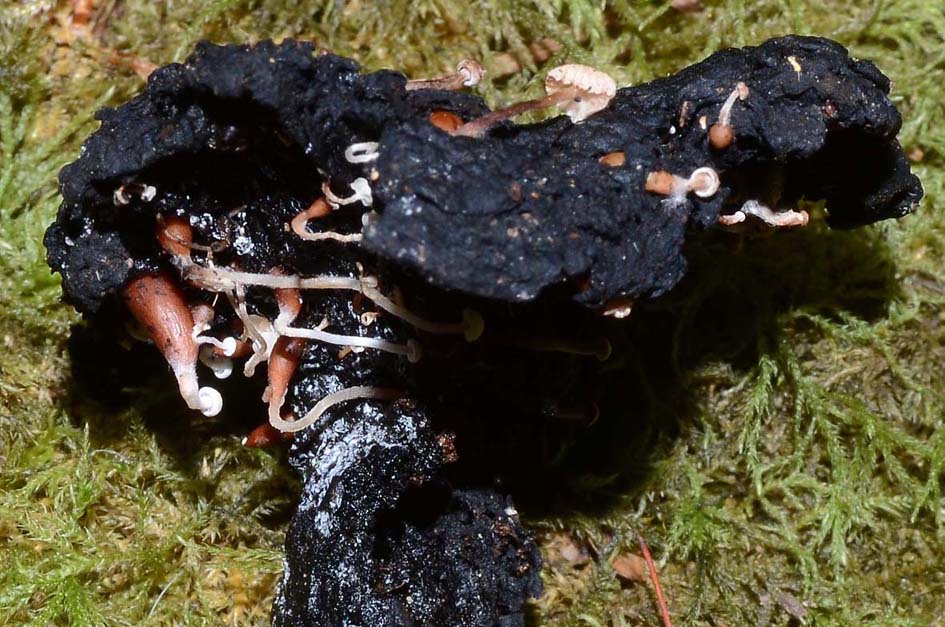
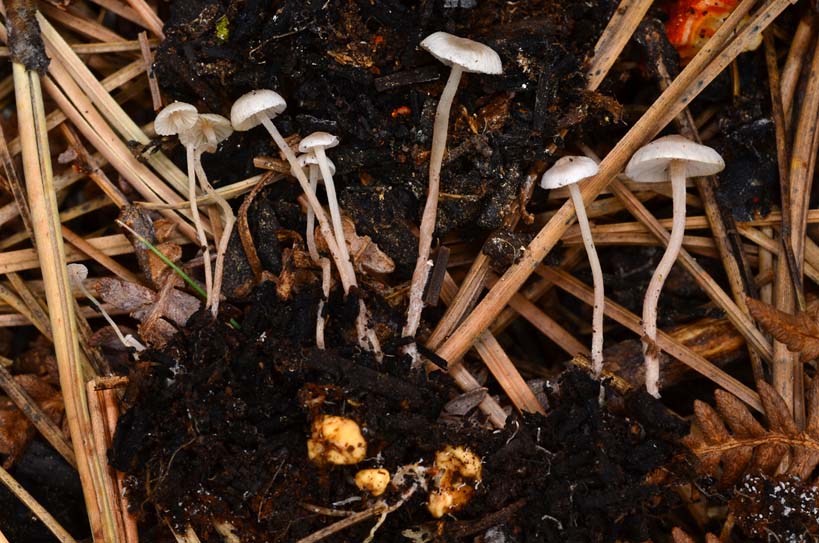
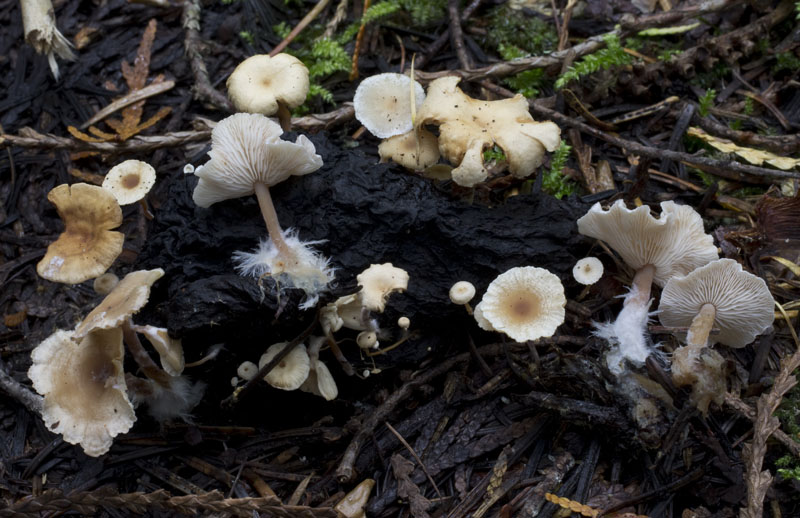

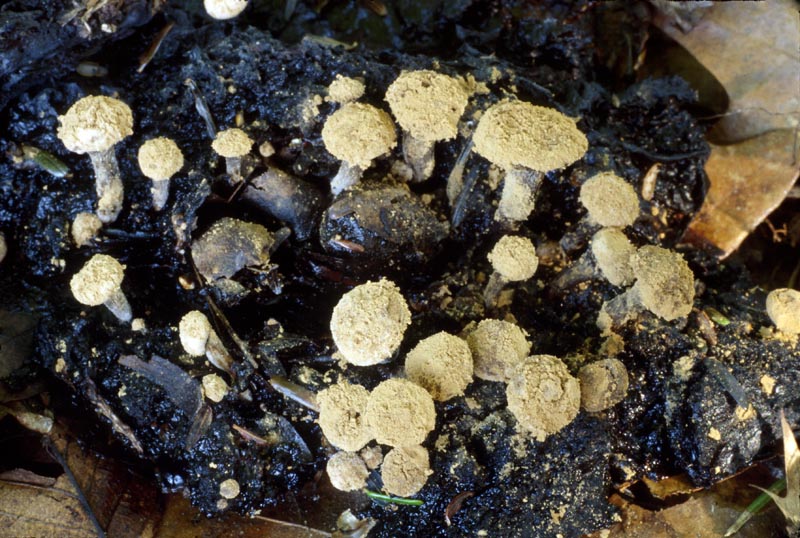
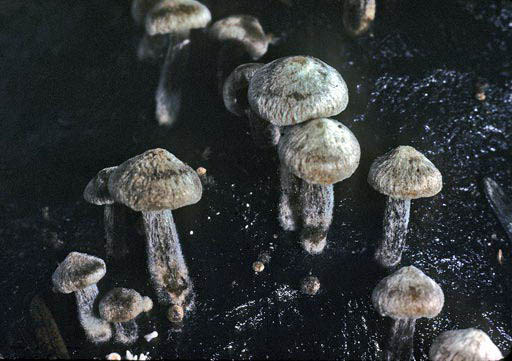
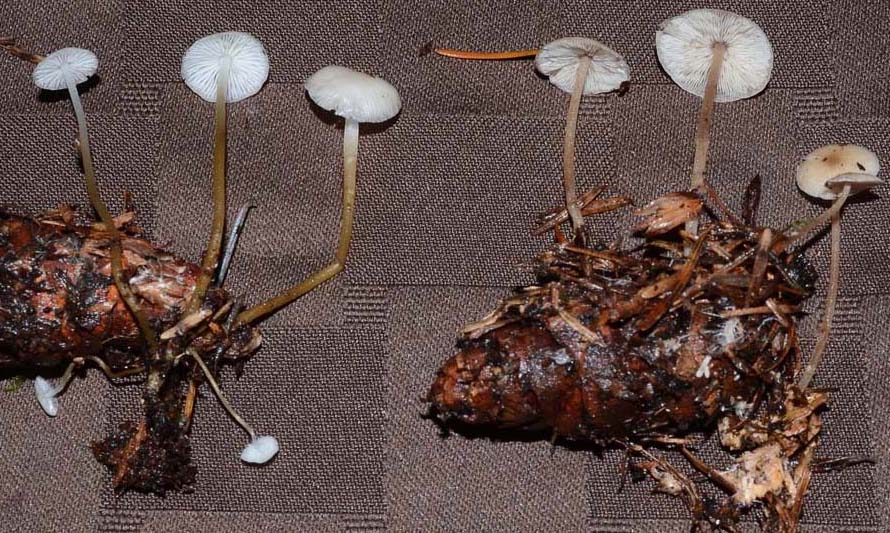
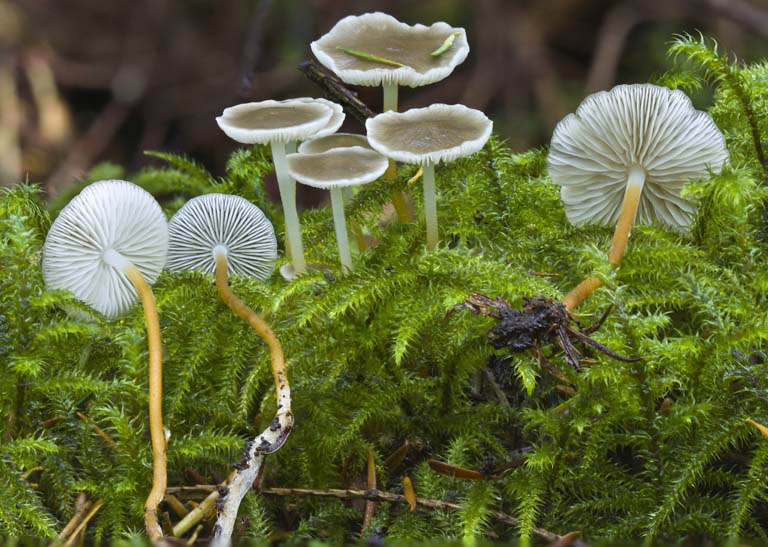
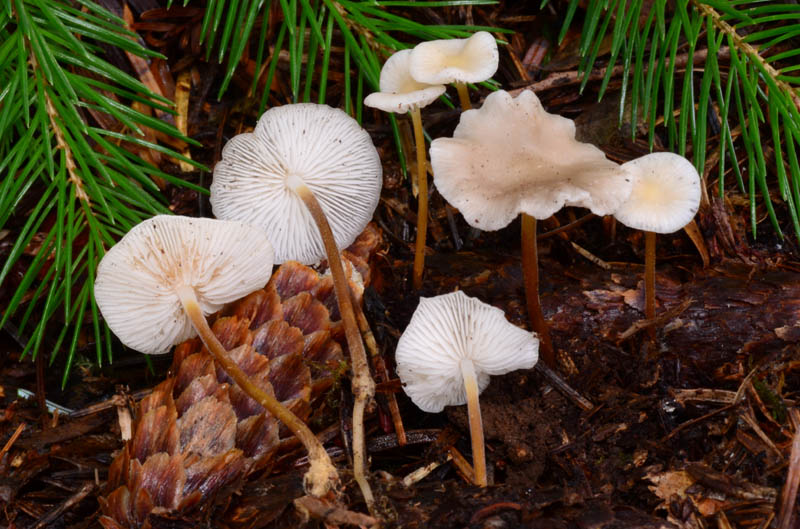
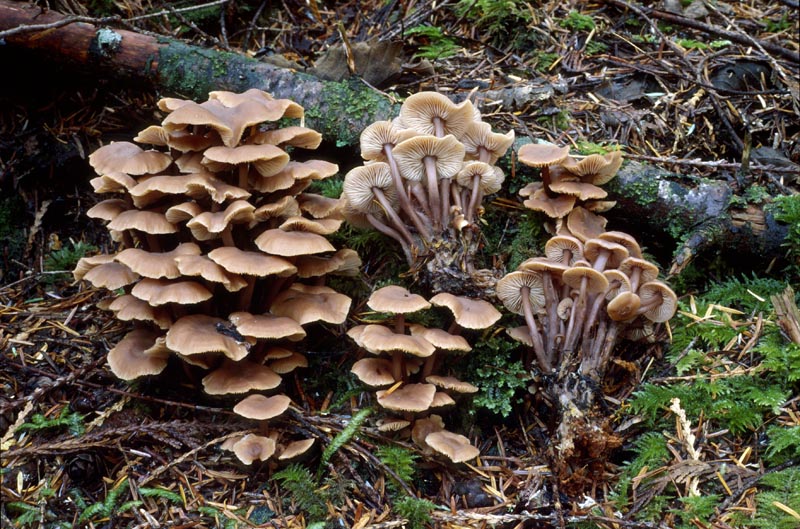
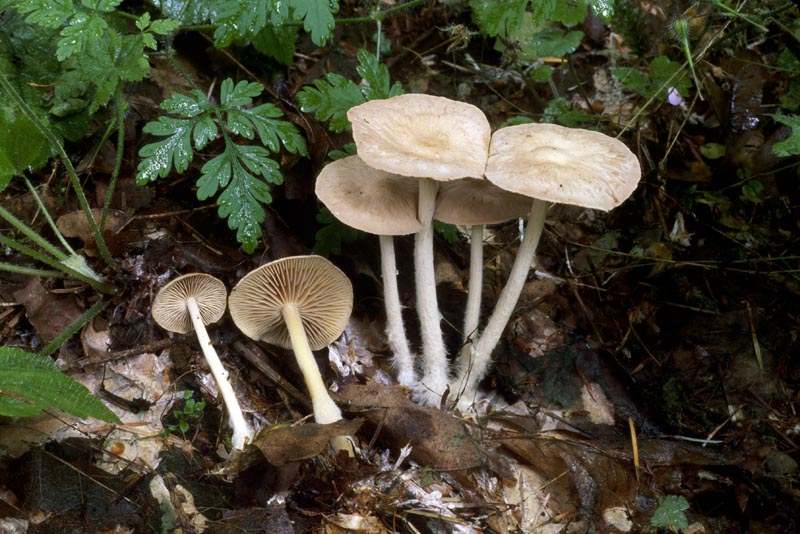
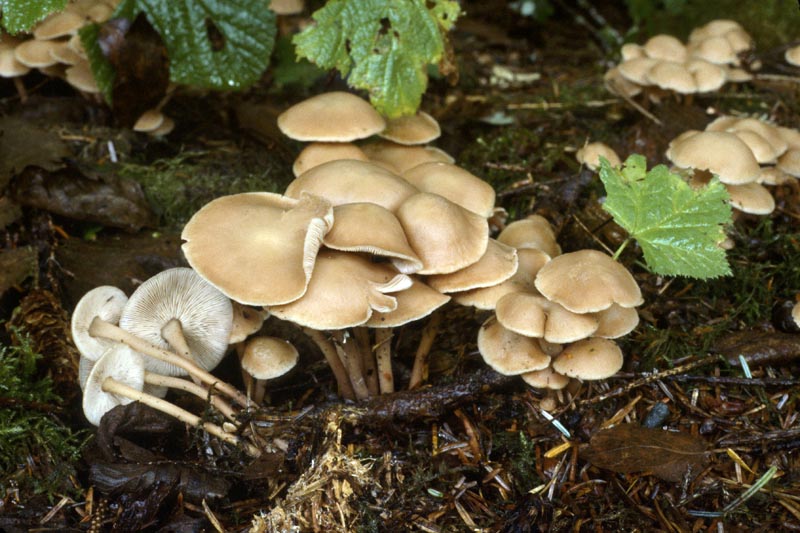

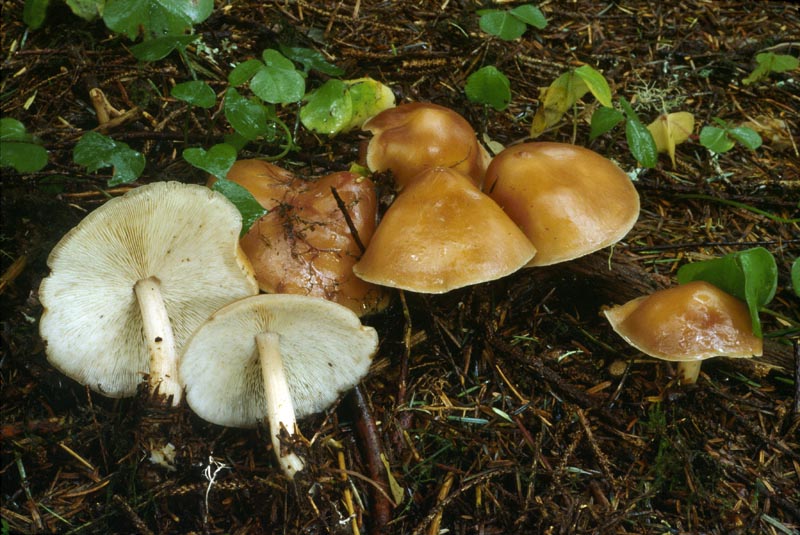
.jpg)
